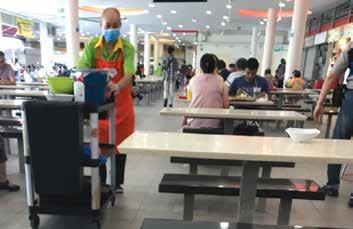
4 minute read
Writers' Block
a contribution from our AWA Writers' Group members.
My Equatorial Malaise
Advertisement
Recently, I was surprised to find myself in an equatorial malaise. “Equatorial” because I’m essentially living on the Equator. “Malaise” as in a lethargic state. Some might call it a funk, but it felt like something more. Like a durian had fallen on my head. I’d lost my Singapore mojo. I sat down to write – something I really enjoy doing on most days -- only to find myself swirling about without much inspiration. I have no idea why, but Schrödinger’s cat came to mind. A completely random thought? No, as it turned out. An inspiring one. Perhaps you’ve heard of Schrödinger’s cat? With apologies to my animal-loving friends, anyone with a passing knowledge of quantum physics, and those of you who didn’t come to Singapore to think about physics at all, I’ll hit the highlights. Schrödinger was a scientist in the 1930s who didn’t think much of a theory of physics called the Copenhagen Theory. The scientists who came up with the theory argued that “quantum” objects (really small stuff, like atoms or even smaller) could exist in all of their possible states at the same time. Essentially, if their theory was correct, it meant that these tiniest of objects could be in more than one place at once – a situation called “superposition.” Schrödinger came up with an imaginary experiment to show why he thought the Copenhagen Theory was misguided. He imagined a cardboard box that contains a few atoms, a flask of poison, and a cat. The atoms were rigged so that when they decayed like all atoms do, they would break the flask, release the poison and (I’m sorry) kill the cat. If the Copenhagen Theory was correct, the atoms in the imaginary box could be both decayed and undecayed at the same time. Which meant the flask in the box could be both broken and unbroken. Which meant the cat in the box could be both alive and dead. Which, Schrödinger noted, was ridiculous. With the passage of time, Schrodinger’s cat turned out not to be so ridiculous after all. It turns out that superposition, at least for quantum objects, really happens. I’m not saying that being an expat is like being alive and dead at the same time. It’s so much better than that. But being an expat does involve superposition. Think about it. How many times have you wandered around with your body in Singapore but your heart back “home?” And how many times have you made a trip back home only to be thinking of Singapore? Two states of existence at the same time. That’s superposition on a very personal scale.
Written by Amanda Jaffe
Given this, perhaps my equatorial malaise was understandable. It’s a lot of work being in two worlds, or in two states of existence, at once. If anyone had bothered to ask Schrödinger’s cat, he might have agreed. Or he might have agreed and not agreed at the same time. Even if superposition does exist, physicists will still tell you that you can’t extrapolate from superposition in the quantum world (which, again, operates on a really small scale) to the everyday “big-world” reality we experience around us. Schrödinger had a point there. But those physicists have never been to Singapore, where I’ve personally seen a stall in a hawker center that sells chicken rice, extra chicken, extra rice, chicken only, and rice only, thus doing an excellent job of proving that chicken rice, like quantum particles, can exist in all of its possible states at once. Whatever the cause of my equatorial malaise, I soon found my joy again. In the course of a single Singapore day, I walked past a vending machine that bills itself as the world’s first salmon-dispensing ATM, downed an amazing banana fritter around the corner, saw otters frolicking in Marina Bay, and gazed at a 27-foot-long sculpture of a baby that weighs seven tons and balances entirely on one hand. If being an expat means existing in two places simultaneously, it’s your brilliant good fortune that one of your two places is Singapore. This is the home of wild roosters, gardens (both by the bay and otherwise), Thaipusam, lion dances, glowing lanterns, five-foot ways, hawker centers, astounding vending machines, durians, kopi, wandering otters, hornbills, “can,” “cannot,” glittering Marina Bay, riverboats with eyes, celebrity orchids and a waterspouting Merlion, just to name a few. If you suffer from a case of equatorial malaise, you need only look around to find wonders, big and small, that will restore your soul. Singapore may not be perfect (no place is), but it’s frequently amazing and endlessly surprising. It will make you shake your head, and it will make you smile with wonder. That’s a pretty good position to find yourself in. Some might even call it “super.”
The AWA Writers’ Group meets the second and fourth Thursday to discuss their work. For more information, send an email to writers@awasingapore.org










